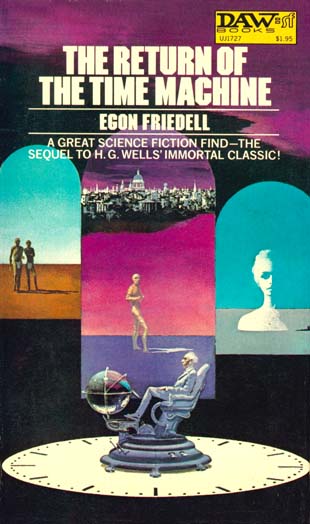 Text
on the backside of the book
Text
on the backside of the bookThe
Return of the Time Machine
by Egon Friedell
DAW:sf books paperback, USA 1972, 128 pages
Translated by Eddy C. Bertin
Original German title: Die Reise mit der Zeitmaschine
Cover art and four illustrations by Karel Thole
 Text
on the backside of the book
Text
on the backside of the book
Undoubtedly
the most perfect science fiction gem is H. G. Wells' world-famous novel THE
TIME MACHINE.
This marvelous story of the inventor of the time-traveling machine and his trip
in it to the far future is a classic that has thrilled the world in books and
films since the turn of the century. But there had never been a known sequel
to it.
Now such a sequel has been found and DAW Books is proud to present its first
appearance in English.
Here then is the rest of the story of Wells' Time Traveller, of his further
visits to the future, and of the Time Machine's desperate entanglement with
the past. Like the original classic, it is a clever, ironic, and always fascinating
novel which contains thought-provoking theories of time and society as well
as being a science fiction adventure hard to put down.
Dramatis personae
Mr.
Egon Friedell - the Austrian Actor
Mr. James Morton - the (grumpy) time traveller
Mrs. Dorothy Hamilton - the (cranky) secretary
Mr. Anthony Transic - the journalist
Mrs. Laura Transic - Anthony's wife
Miss. Gloria - a young woman
A young man from Savory & Son
Two Egyptians
My review
It starts with a correspondence between Egon Friedell and H. G. Wells (but it is the secretary who answers the letters and then the journalist) and this is a little bit too long, but gives the novel a realistic touch as does the time travel explanations à la Jules Verne. But when you look closer at the explanations, they are not air-tight/logical. For example: Friedell talks about moving Earth, the moving Sun and the moving stars but despite this, the Time Machine stays in the space of the Time Travellers writing-room, when travelling through time. And the Time Machine itself must be in the size of a bicycle, because the Time Traveller can take it with him. And how can he confuse it with a cathode-collector? Does a cathode-collector look like a bicycle-size Time Machine or is the Time Traveller myopic? And how can he see miss Gloria sitting and waiting when he is no longer in the space of his writing-room? And London floating in the sky in the year 1995? It is too close to the present time to be believable, and such mistake didn't H. G. Wells do when he took the Time Traveller to the year 802701 and further ...
I did not like this
book very much, because it was too much of this correspondence and (illogical)
time travel explanations and too little adventure. The Time Traveler do not
start his journey until page 43! And in the other hand, the book tries to be
in the original dry Wellsian style, but it is too grumpy for it and also it
has a lot of logical gaps. But it is interesting, because this sequel was written
in 1928 when H. G. Wells was yet alive ... Read it if you like films as Solyaris
a.k.a. Solaris (1972), 2001
- A Space odyssey (1968) and Dark
Star (1974) ...
As a satirical science fiction novel: ![]()
![]()
As a sequel to the original H.G. Wells novel:
![]()
![]()
Sandra Petojevic, Master of Arts in Art History and Visual studies, August 25, 2005
Buy the book - and
see other reviews - on the Net in UK
(hardcover 1987) or USA (paperback)
or (hardcover
1987)
Buy the book from the publisher www.dawbooks.com
(the 1987 hardcover edition is issued from Starmont House Inc. which was founded in 1976 and ceased operations on march 1, 1993. Read about it on Robert Reginald's site www.depauw.edu/sfs/backissues/61/reginald61art.htm)
Denna bok finns även
i en svensk översättning av Sam J. Lundwall i nr. 502-503 av Jules
Verne Magasinet (september 2000) där det även står att romanen
är från 1928 och inte från 1946 som det står i DAW:s
pocketbok.
This book exists also in a Swedish translation by Sam J. Lundwall in no. 502-503
of Jules Verne Magasinet (September 2000) where it also says that the
novel is from 1928 and not from 1946 as it is written in the DAW paperback.
And there is also a goofy translation in the Table of Contents from german to
english: It is Julius Caesar and his hobby - not Julius Caesar and
the Indians!
Back to sequels, click here.